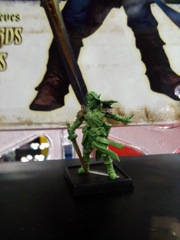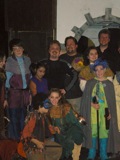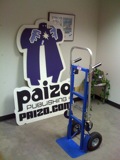Launching Our Own RPG
Thursday, September 27, 2012
This blog entry is the eighth in a series of blogs commemorating Paizo's 10th anniversary.
Click here to read the first installment.
One of the things that has plagued Paizo through most of its existence is that every year, we end up throwing a major project or two on top of an already full product release schedule. In 2005, it was the Shackled City hardcover. In 2006, it was the Dragon Compendium, Monster Ecologies and the Kill Doctor Lucky board game. In 2007, we launched our Adventure Paths and Modules lines as well as the Stonehenge board game. In 2008, we published the hardcover campaign setting sourcebook and launched the Player Companion line, and we ran the Pathfinder RPG playtest as well.
Surprise! 2009 wasn't any different. And this time, we were taking on perhaps the biggest add-ons yet: the Pathfinder RPG Core Rulebook, weighing in at 576 pages, and the Bestiary, with its hefty 328 pages. All told, we were adding more than 900 pages to our regular workload. It ended up requiring hundreds of hours of overtime and the combined effort of dozens of employees.
One of the first decisions to make was the physical form that our rulebooks would take. Traditionally, the core D&D rules encompassed three volumes: the Player's Handbook, the Dungeon Master's Guide, and the Monster Manual. We thought about following a similar format for Pathfinder, but it had always bugged us that players needed to own the DMG if they wanted to look up magic items, so we decided to wrap all of the information that you would need to run a game of Pathfinder, minus the monster writeups, into a single Core Rulebook. The Bestiary would remain its own book.
We also had to make a huge decision about how far we were going to stray from the 3.5 SRD. Our alpha playtest had introduced a number of new systems that pushed the boundaries of backwards compatibility. Ultimately, we decided to keep Pathfinder fairly close to its 3.5 roots while using years and years of GM experiences to update and fine-tune the system. We certainly didn't fix everything we could have in 3.5—some issues are endemic to the math underlying the core system—but we did fix a lot of the problem areas.
So why did we swing the pendulum toward backward compatibility? Because our customers were telling us that they didn't want their trove of 3.0 and 3.5 books to become obsolete. Everyone had a pile of Wizards of the Coast products, of course, but the OGL and the d20 license had also inspired an explosion of print and PDF books the likes of which the gaming industry had never before seen. And we really wanted people to be able to use all of those products with Pathfinder. For the most part, I think that we did a good job striking the balance between compatibility and innovation.
Not surprisingly, the new RPG had a huge effect on the rest of our product lines. Since we were launching a new system at Gen Con, all of the other products scheduled to be released from that date forward needed reflect the new rules. The problem is that we usually contract freelance writers eight months or so before the intended release date of a product, and the rules were still in flux at that point. What to do?
We decided to contract in-house authors to write the first adventures and adventure path volumes for the new game. Since our own people were working with the new rules as they were being written, we figured that they would be in the best position to use those rules to write adventures. Even hedging our bets that way, we still had lots of issues, but at least they could be worked out in person and in real time, rather than via email or telephone. Still, not a task for the faint of heart. Whenever possible, we also planned products that were relatively rules light for much of the year.


As we prepared to send the game to the printer, we faced another big question—how many Core Rulebooks should we print? Until this book, we'd mainly printed adventures and campaign sourcebooks, products aimed pretty much exclusively at GMs. Now, for the first time, we had a book that was aimed at players. We ended up setting a print run three times as big as any other print run we had ever made. The cost was staggering and a bit unnerving. But distributor orders flooded in, and we sold out of our first print run before it even arrived from the printer! We were floored. We thought that the Pathfinder RPG was going to do well, but none of us thought that we'd sell out of a print run three times bigger than any other print run... and before the product was even released. It gave us an early indication of the success that the Pathfinder RPG was going to have. We ended up setting our second print run even higher than the first, committing Paizo to TWO staggering print bills before any money even came in from the first sale!
Of course, shipping all those books around the world also ended up being a bit of a struggle. We always pride ourselves in doing a great job of packing our shipments, but the hardcover Core Rulebook made us re-evaluate our processes, eventually leading us to use book corners to keep the books pristine. Another hurdle was the weight of the book. In 2007, the USPS discontinued surface mail, meaning that everything now goes by air, and international shipping costs go through the roof if your parcel weighs more than four pounds. The Core Rulebook exceeds that limit before you even add the weight of box and packaging materials! To this day, customer service continues to deal with a ton of emails and messageboard posts from customers complaining about the cost of shipping the Core Rulebook.
We also had a big debate when it came to pricing the Core Rulebook PDF. Normally, our PDFs are priced at about 70% of the cover price of the corresponding print edition, a formula that would result in a price of $34.99 for the Core Rulebook PDF. But we had already decided to post the rules themselves for free on the Pathfinder Reference Document, so the price to have them neatly laid out and beautifully illustrated needed to be something much closer to "free." We ended up settling on $9.99, and right out of the gate, PDF sales were astounding. We earned so much goodwill from that decision that we've continued to offer all of our rulebooks in PDF form at that price.
We also had to decide how we were going to let other publishers interact with the Pathfinder rules. We had long been believers in the OGL, so we never considered anything other than making our rules completely open. However, the OGL specifically prohibits publishers from saying their products are compatible with trademarked brands like "Dungeons & Dragons" or "Pathfinder" without another agreement, so we came up with the Pathfinder Roleplaying Game Compatibility License, which has allowed the existence of hundreds upon hundreds of Pathfinder RPG–compatible products by dozens and dozens of publishers. The growth of the third-party community has been one of my favorite parts of the whole Pathfinder RPG business.
We also created our Community Use Policy, which has allowed customers and fans to create an incredible diversity of free products, websites, and other materials that expand our game and our world in ways that we never imagined.
One great example of this community collaboration is Wayfinder. Originally plotted as a fanzine to be given away at the first official PaizoCon, Wayfinder has become a biannual publication that recently released issue #7. It has earned a lot of praise from the gaming community, even garnering its own ENnie award nominations. Liz Courts originally helmed the editor-in-chief role for Wayfinder, but she turned that title over to PaizoCon founder Tim Nightingale when we hired her on at Paizo.
One benefit of the success of Pathfinder is the ability to license other companies to produce Pathfinder products. One such deal in 2009 was with Q-Workshop, to produce a line of dice themed around our Adventure Paths. To date, they've released six sets of Pathfinder dice.
In 2009, we landed one of our bigger licenses in Reaper, producing unpainted metal miniatures. We had initially licensed Crocodile Games to make Pathfinder minis, and their figures were great, but they were just coming out too slowly for us. So after a year or so, we decided to give Reaper a call to see if they were interested. Imagine our surprise when we not only received a "yes" but a resounding "Hell yes!" from them. With two to four minis released every month, Reaper has built up quite a stash, with 153 different figures in release or on the way as I type this!
The second year of our RPG Superstar contest saw an increase in the number of contestants. Original judge Erik Mona had to drop out as we were keeping him way too busy, so Sean K Reynolds came in as his replacement. Contestant Neil Spicer emerged as the victor with his Realm of the Fellnight Queen proposal. Neil is the quintessential RPG Superstar: hitherto undiscovered talent that Paizo has since come to rely upon. Since his victory, Neil has authored five Adventure Path volumes (contributing to Kingmaker, Serpent's Skull, Carrion Crown, Jade Regent and Skull & Shackles), and he has gone on to become one of RPG Superstar's best judges as well! In its first two years, RPG Superstar had already brought Paizo a number of great freelancers, as well as two employees—not a bad start!
2009 was also the year we took over PaizoCon as an official Paizo convention. We were all impressed with the job Tim Nightingale did with 2008's fan-run PaizoCon, but it was clear to everyone that it could be so much more if we as a company got behind it. Interestingly enough, the impetus for this move saw its genesis in another convention, the Origins Game Fair in Columbus, Ohio. Origins had been a big and important convention dating back to the '70s. For decades, Origins and Gen Con were the cornerstones of the summer convention season for many publishers. But over the years, Gen Con had grown in prominence on the national stage while Origins slipped away to become a large regional show. Paizo had been going to Origins since our inception, but we'd been spending an increasing amount of money attending the show each year. Sending a large portion of our staff across the country, providing them food and lodging, buying space in the dealer hall, and shipping our booth and product across the country is very expensive, and sales in the dealer hall continued to decline each year as attendence fell. So we decided to make a corporate decision—if we were going to (hopefully) just break even each year on a convention, we might as well make it one that we owned, right here in the Seattle area.
 A mountain of Core Rulebooks awaits the swarm of gamers on the first day of Gen Con! There are more copies underneath the black cloth... and we sold them all!
A mountain of Core Rulebooks awaits the swarm of gamers on the first day of Gen Con! There are more copies underneath the black cloth... and we sold them all!So we reached out to Tim and asked him if we could take over PaizoCon for 2009. He gladly accepted and we were off to the races! Our first problem was securing a location. Tim's 2008 PaizoCon had around 50 attendees, and since we were aiming to have three or four times that many people for PaizoCon 2009, we needed a bigger space. We soon learned that most hotels are either set up for small corporate conferences the size of the first PaizoCon, or they're optimized for thousands of attendees. It seemed we were exactly the wrong size. After months of searching, we stumbled across the Coast Hotel in Bellevue, just minutes from where our office was. Its size proved perfect for the next couple of years as the con was growing. We were able to take most of the rooms in the hotel, packing it with gamers from top to bottom. The Coast gave PaizoCon a very intimate feeling that suited us just fine. We ended up having just over 200 paid attendees for PaizoCon 2009, plus another 50 or so guests and staffers. Our first ever Guest of Honor was super designer Monte Cook and his wife Sue, while our first artist Guest of Honor was Eva Widermann.
One of the big surprises for us was how well the Paizo store did at the show. We'd anticipated that only the most hardcore Paizo enthusiasts would journey all the way out to Seattle to attend PaizoCon, and hardcore fans—pretty much by definition—tend to already have everything you've made. So we expected sales to be tepid at best. To our surprise, we've eclipsed our budget for the Paizo store each year at the con.
Gen Con was a very big deal for Paizo in 2009, for it was the first public release of the Core Rulebook. Our big question for the show: How many Core Rulebooks do we bring to sell? Memories of the year we brought too many copies of the Shackled City hardcover haunted us. We wanted to have enough rulebooks to last the entire convention, but we didn't want to ship pallets of the books home if we brought too many. To complicate matters, we knew that the quantity we were earmarking for Gen Con would be among the very last unsold copies of the first printing of the book, so for many folks, this was going to be one of the only ways to get the book for a few months while we waited on the reprint. We decided to go big, bringing a ton of books to the con, using cases of books to build a huge table in the middle of our booth, stacking more books on top.
When the doors opened on the first day of the show, the tidal wave of customers rushing to our booth was staggering. Chaos ensued, and it took the combined might of the entire Paizo staff to wrangle a semblance of order to the line, which wrapped around our booth once and then tailed off into the art show next door. In order to get people through the line quickly, I borrowed an idea from White Wolf's successful Gen Con launch of the Werewolf RPG. I quickly grabbed Erik Mona, and we gathered a box and a pile of books and headed down the line. If anybody in line was buying only the Core Rulebook, they could give us $60 cash—the cost of the Core Rulebook plus sales tax, rounded up to avoid making change—and leave the line, book in hand. Dozens and dozens of people took us up on our offer, and we were able to cut the line down to a paltry two-hour wait! Amazingly, we did a nearly perfect job predicting the number of books we needed, selling our last copies late on Sunday!
At the ENnie Awards, Paizo won 4 golds and 2 silvers. The awards received were:
- Best Art, Cover: Silver Medal for Pathfinder #19, Howl of the Carrion King
- Best Cartography: Gold Medal for Pathfinder Chronicles Second Darkness Map Folio
- Best Adventure: Gold Medal for Pathfinder #19: Howl of the Carrion King
- Best Setting: Gold Medal for Pathfinder Chronicles Campaign Setting
- Best Miniatures Product: Gold Medal for Flip-Mat: Waterfront Tavern
- Best Publisher: Silver Medal
When we got back from Gen Con, there was no rest for the weary; we had to move our entire operation from our old office in Bellevue to our new office in Redmond. For much of the previous year, we had been desperately searching for new office space to suit our changing needs. When we moved into our Bellevue office a few years before, we were a magazine business with a fledgling e-commerce store. Our warehouse needs were small. As our business had shifted to book publishing, pallets of new products were filling our warehouse, spilling over into the underground parking garage. We needed new office space with a seriously large warehouse, and soon. But on Seattle's east side, a fairly large office space adjoining a fairly large warehouse space is not a common combination. We searched high and low, and only at the last minute did we find the space we are currently in. Our new space had been leased by two separate tenants who both went bankrupt at the same time, leaving the landlord with half a building and a big warehouse to fill. He was very excited when we said we would take over the space with only minor changes.
As 2009 came to an end, Paizo was firmly settled into our new digs, and the Core Rulebook was selling so well that we were already preparing for a third printing. The Bestiary had just been released and was also seeing great sales. It was looking like Paizo was going to weather the shift to our own RPG game system with flying colors. Now we had the challenge of building on the successes of 2009 to establish Pathfinder as the preeminent brand in RPG gaming. A lofty task that was going to take a lot of hard work and a little bit of luck...
Employees who started in 2009 (in order of hiring date):
Ross Byers, Assistant Software Developer
Crystal Frasier, Production Specialist
Will Chase, Warehouse Specialist
Sara Marie Rip (now Teter), Customer Service Representative
Rob McCreary, Assistant Editor
Employees who left in 2008 (in order of their end date):
Drew Pocza
Brock Mitchel-Slentz
Alison McKenzie
Lisa Stevens
CEO
My Path to Adventure
My time with Paizo began with the inaugural RPG Superstar competition in 2008. I was living in Prague, Czech Republic at the time, and entered the contest on a whim. I ended up as one of the Top Four finalists, which led to my first freelance gig for Paizo, working on the Pathfinder Chronicles Campaign Setting. From that time on, I was hooked. I went to Gen Con UK in Reading, England specifically to meet Erik Mona, Jason Bulmahn, and Josh Frost (and joined Erik's trivia-dominating "Coalition of the Willing" team), and to play in Season 0 of Pathfinder Society organized play. And I kept bugging James Jacobs and Wes Schneider for more freelance work.
By 2009, I knew I wanted to work at Paizo full time. There were only two problems: I was still living in Europe, and Paizo didn't seem to be hiring. I decided to go and meet some of the Paizo staff in person, to put more names to faces, and even more importantly, give them a face to go with the name of their freelancer-in-Europe whom most of them had only talked to in emails. I flew back to the States to attend PaizoCon 2009, and while I was there, I made a point of mentioning to Lisa, Erik, James, and Wes that I wanted to work for Paizo, that I was willing to move back to the US to do so, and to keep me in my mind if they had any job opportunities.
In September, an editorial assistant position at Paizo did open up, and I wasted no time applying for it, once more assuring Wes that I was definitely willing and able to move back to the States for the job. After an editing test, a Skype interview (the only interview question I remember is Lisa asking me what class would I be if I were a Pathfinder RPG character), and lots of emails back and forth, I sat back to wait, and worked on convincing my European wife, whom I had just married a couple of weeks before, that moving to the US was a good thing.
I received word that I got the job in the middle of my honeymoon in Greece, and suddenly my wife and I had to start preparing for the move we had talked about but never really thought would happen. I had less than a month to get everything ready to move from Prague to the Seattle area, and on November 1, I started my first official day working for Paizo. Since then, I've moved from editing to development, and now I spend most of my time developing the Pathfinder Adventure Path.
Almost three years later, I still have trouble believing how everything worked out. Like almost every gamer, I used to dream of being a game designer, but I never seriously pursued that goal and never thought it would happen. I entered RPG Superstar on a whim, and fell in love with writing and working for Paizo.
I can honestly say that this is the best job I have ever had, and though it's hard work a lot of the time, it's also fun. Every day, I get to work with some of the best freelancers in the industry, and collaborate with amazing people who are passionate about their work and their play at a company that truly cares about its employees, its fans, and the game we all love.
Rob McCreary
Developer
Customer Carebear Stare!
Mostly by sheer chance and dumb luck, I ended up in a gaming group with a GM who was really excited about this Pathfinder thing. He convinced the group to try out the Beta Playtest, and was also able to convince me to go to PaizoCon and tack on a banquet ticket.
The staff I met were super friendly, willing to just hang out and chat, and the members of the community I met were very inclusive. I left wishing I knew game design, not because I wanted to design games, but because I wanted to work at Paizo.
Several months later, someone in my gaming group casually mentioned Paizo was hiring for customer service. The listing had been up for a while, so I knew I needed to act fast. I nearly talked myself out of applying a million times. In the end it came down to knowing that never trying would hurt worse than the rejection of not being chosen.
I was asked to come in for an interview. I can't even begin to describe the nervous panic. Butterflies in the stomach, palms sweating, I sat in the conference room waiting, and then Cosmo poked his head in to let me know it would be just a few minutes until Lisa was ready. The CEO? In my interview? Ack! I did my best to stay outwardly calm while my insides turned to jelly. However, Lisa, Jeff, and Cosmo were great, and it immediately felt like a conversation rather than an interview. I kept realizing over and over how much I wanted to work with these people. The atmosphere and company philosophy were exactly what I was looking for. I left convinced Paizo would be perfect for me, but I was sure I would never get the position.
When Jeff called and offered me the job, I was through the roof. Uprooting to a whole new job and learning on a sharp curve? Bring it! Commute twice as long? Sure. Considerable pay cut? I'd make it work.
And I am so glad I did.
I found a job where I not only like my coworkers, but I like the customers. I found a company that actually cares about all levels of employees and actively encourages thinking about how to make things better for the customers. I was completely shell-shocked the first time I made a suggestion to Cosmo, and he said "Yeah, that's a good idea; go talk to the tech team and see if it's possible." And then the tech team said, "We'll have it ready the next time we roll the site." And then the next time they rolled the site, there it was: my idea, out there, making customers' experiences better! I found a place where I feel like I fit in.
I also found a husband, so that might be biasing my experience slightly.
Sara Marie Teter
Customer Service






